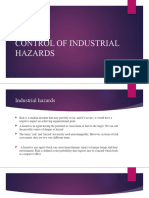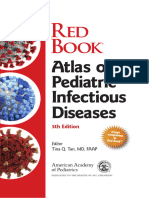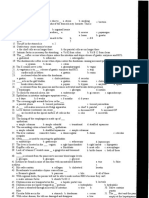First Aid Risk Assessment PDF
First Aid Risk Assessment PDF
Uploaded by
Amin UllahCopyright:
Available Formats
First Aid Risk Assessment PDF
First Aid Risk Assessment PDF
Uploaded by
Amin UllahCopyright
Available Formats
Share this document
Did you find this document useful?
Is this content inappropriate?
Copyright:
Available Formats
First Aid Risk Assessment PDF
First Aid Risk Assessment PDF
Uploaded by
Amin UllahCopyright:
Available Formats
4.
REVIEWING YOUR
FIRST AID REQUIREMENTS
You should regularly review your first aid arrangements in consultation with your workers to
ensure they remain adequate and effective.
Check that the people who have responsibilities under your first aid procedures are
familiar with them.
If the way work is performed is changed, or new work practices introduced, review first
aid against a risk assessment to ensure the arrangements are still adequate.
Organise a mock first aid emergency to check that first aid is effective. Check that kits
and first aid rooms are accessible and suit the hazards that are unique to your workplace.
If an incident has occurred that required first aid, evaluate the effectiveness of the first
aid that was provided and make changes if necessary.
If new information is obtained about a previously unidentified hazard, review the first aid
measures you have put in place.
The following questions can assist you to review first aid and assess whether improvement
is needed:
Do the first aid kits and modules suit the hazards at your workplace?
Are more first aid kits required?
Are first aid kits accessible to workers?
Are first aid kits well maintained and identifiable to workers?
Is a first aid room or health centre required?
Are first aid facilities well maintained?
Do first aiders have the skills and competencies required of them and are their
skills up-to-date?
Do workers know how to access first aiders?
Are more first aiders needed?
Do workers have access to first aiders at all times?
Do workers and other people know what to in an emergency situation?
Is there easy access for emergency services, such as parking for an ambulance?
CODE OF PRACTICE | FIRST AID IN THE WORKPLACE 17
APPENDIX A - FIRST AID AND
THE RISK MANAGEMENT PROCESS
Step 1 – Identify potential causes
of workplace injury and illness
Does the nature of the work being carried out pose a hazard to people’s health and safety?
Have these hazards been identified in work that is being carried out?
Has incident and injury data been reviewed?
Has consultation with workers and their health and safety representatives occurred?
Is specialist or external assistance required?
Step 2 – Assess the risk of workplace injury and illness
How often does a hazard have the potential to cause harm?
What type of injuries would the hazards cause?
How serious are the injuries?
Does the number and composition of workers and other people affect how first aid should be provided?
Could the size and location of the workplace affect how first aid is provided?
Step 3 – What first aid is required?
First aiders First aid kits & procedures First aid facilities
How many first What kits/modules are needed and Is a first aid room
aiders are needed? where should they be located? or health centre
required?
What competencies Is other first aid equipment needed?
do they require?
Who is responsible for maintaining
What training do the kits?
they need?
What procedures are needed
for my workplace?
Step 4
Review first aid to ensure effectiveness
18 CODE OF PRACTICE | FIRST AID IN THE WORKPLACE
APPENDIX B - EXAMPLE OF A FIRST
AID ASSESSMENT
This assessment of first aid requirements is included as an example only. It does not reflect the consultative processes
that must occur or detail the assessment of each identified hazard.
ABC Company - Office and manufacturing operation
The size and location of the workplace
Number of floors 2
Access between floors Lifts and stairs
Nearest hospital 6 kilometres
Nearest medical or occupational 2 kilometres
health service
Maximum time to medical service 15 minutes
The number and composition of the workers and other persons at the workplace
Number of workers 80 (15 office / 65 factory)
Number of other persons 2 to 5 visitors per day
Shifts 3
Overtime worked Yes – regularly
Remote or isolated workers None
Injuries, illnesses and incidents
Last 12 months’ claims data 5 x abrasions
3 x falls
Incidents not resulting in injury Incident where a trolley carrying disinfectants overturned
Other Worker handling a solvent reported symptoms of eye irritation and
dizziness
CODE OF PRACTICE | FIRST AID IN THE WORKPLACE 19
APPENDIX B - EXAMPLE OF A FIRST AID ASSESSMENT
Nature of the work being carried out and the nature of the hazards at the workplace
Hazards How the hazard could Likelihood of occurrence and degree
cause harm of harm
Hazardous chemicals: Respiratory Possible risk of daily exposure to
Solvents
illnesses, cancers hazardous chemicals for 2 cleaners.
and dermatitis Good ventilation is provided. Protective
Disinfectants equipment such as gloves and aprons
are used by workers.
Noise Hearing damage Possible risk of daily exposure to noise
for 65 factory workers. Low noise
Manual handling Muscular strain
emitting machines have been purchased.
Protective equipment such as ear plugs
is used by workers.
Low risk of daily exposure to manual
handling risks. Mechanical aids, work
station alterations and systems of work
significantly eliminate and reduce risk
Do safety data sheets and labels specify a first aid response? Yes – seek medical assistance if chemicals
are inhaled or ingested
Required first aid
Number of first aiders needed 9 – minimum 3 per shift (1 for office and 2 for the plant)
Training and competencies Applied First Aid: providing competencies to recognise and respond
for first aiders to common life-threatening injuries or illnesses using cardiopulmonary
resuscitation (CPR) and other first aid procedures, and provide
appropriate first aid for a range of injuries and illnesses.
Number and location of kits 5 kits: one on the office floor and four on the factory floor
Contents of first aid kits and Standard workplace kit, with burns module and eye module
modules
Kit maintenance Tasked to 6 first aiders
20 CODE OF PRACTICE | FIRST AID IN THE WORKPLACE
You might also like
- Waiters Postpartal Hemorrhage PDFDocument1 pageWaiters Postpartal Hemorrhage PDFTommieNo ratings yet
- Case Study On Bronchial AsthmaDocument29 pagesCase Study On Bronchial Asthmamanny valenciaNo ratings yet
- OSHJ-CoP-16 First Aid at Work Version 1 EnglishDocument12 pagesOSHJ-CoP-16 First Aid at Work Version 1 EnglishsajinNo ratings yet
- COSHHDocument1 pageCOSHHnicholasNo ratings yet
- A Guide To in The: First AidDocument20 pagesA Guide To in The: First AidsanjeevchsNo ratings yet
- 2015-330Document29 pages2015-330Saad KamranNo ratings yet
- Module 6 - 4 Osh Program DevelopmentDocument16 pagesModule 6 - 4 Osh Program DevelopmentRy100% (1)
- SITXWHS001 Assessment.v1.0 Phurba Gyalje SherpaDocument10 pagesSITXWHS001 Assessment.v1.0 Phurba Gyalje SherpaPhurba SherpaNo ratings yet
- Hazard Register ConstructionDocument15 pagesHazard Register ConstructionMohd ObaidullahNo ratings yet
- A05-Safety Observation & CommunicationDocument56 pagesA05-Safety Observation & Communicationing.cbrito100% (1)
- OHSA SafetyDocument2 pagesOHSA SafetyKyrlle LiwanagNo ratings yet
- IMS Checklist 5 - Mod 4Document9 pagesIMS Checklist 5 - Mod 4Febin C.S.No ratings yet
- Bosh PDFDocument75 pagesBosh PDFart031125No ratings yet
- Hand Out Maintenance Course For EngineersDocument109 pagesHand Out Maintenance Course For EngineersGauravNo ratings yet
- Control of Industrial HazardsDocument19 pagesControl of Industrial Hazardsnickokinyunyu11No ratings yet
- What Is RiskDocument11 pagesWhat Is RiskGaudencio BoniceliNo ratings yet
- Imp Learn From Defects FacnotesDocument30 pagesImp Learn From Defects FacnotesCarissa SulaimanNo ratings yet
- Greenhouse Growers Risks Hazards and SolutionsDocument3 pagesGreenhouse Growers Risks Hazards and Solutionskhant59037No ratings yet
- Chapter 2 Perform First AidDocument7 pagesChapter 2 Perform First AidJestoni MaravillasNo ratings yet
- 30-Hour Construction Safetey - Updated (2017 - 09 - 04 12 - 51 - 06 UTC)Document393 pages30-Hour Construction Safetey - Updated (2017 - 09 - 04 12 - 51 - 06 UTC)nuhNo ratings yet
- UV30491 Monitor and Maintain Health and Safety PracticeDocument12 pagesUV30491 Monitor and Maintain Health and Safety Practicekn4xnrg28gNo ratings yet
- Best Practices in Industrial Emergency DrillDocument38 pagesBest Practices in Industrial Emergency DrillAlok kumarNo ratings yet
- Module 6 - 4 Osh Program DevelopmentDocument16 pagesModule 6 - 4 Osh Program DevelopmentleytontamondongNo ratings yet
- 1st Aid SOPDocument9 pages1st Aid SOPDon Mclean100% (1)
- Internal Memo: Hazrds and Unsafe Working ConditionsDocument4 pagesInternal Memo: Hazrds and Unsafe Working ConditionsAsad AwanNo ratings yet
- SITXWHS001 Participate in Safe Work Practices Aakash BhattaraiDocument10 pagesSITXWHS001 Participate in Safe Work Practices Aakash Bhattaraisagar chetriNo ratings yet
- Energy ProjectsHealth Safety ManualDocument51 pagesEnergy ProjectsHealth Safety ManualMuhmed Abdel AlimeNo ratings yet
- Tle He CG7&8 W7 8Document4 pagesTle He CG7&8 W7 8Jonalyn F. LegaspiNo ratings yet
- Controlling Hazard and RiskDocument5 pagesControlling Hazard and RiskRose GutierrezNo ratings yet
- Week 5 and 6Document5 pagesWeek 5 and 6jovelyn nebreNo ratings yet
- ID Evaluasi Manajemen Alat Pelindung Diri Apd Di Instalasi Laundry RsDocument13 pagesID Evaluasi Manajemen Alat Pelindung Diri Apd Di Instalasi Laundry RsSeptario RahmandiaNo ratings yet
- Good Morning Class! February 10, 2021: Tle-CarpentryDocument57 pagesGood Morning Class! February 10, 2021: Tle-CarpentryGlenn Fortades SalandananNo ratings yet
- HiraDocument12 pagesHiraMDR PRAPHUNo ratings yet
- PPE 2011 HandoutDocument25 pagesPPE 2011 HandoutSalve IgnacioNo ratings yet
- Risk Assessment DocumentDocument6 pagesRisk Assessment DocumentCarla LemesNo ratings yet
- Topic C - PERSONAL PROTECTIVE EQUIPMENTDocument43 pagesTopic C - PERSONAL PROTECTIVE EQUIPMENTSn CarbonelNo ratings yet
- Css For Grade 7&8 - FQL3 - BC4 - 3. Control Hazards and Risk - LMS - 2021 - 2022Document10 pagesCss For Grade 7&8 - FQL3 - BC4 - 3. Control Hazards and Risk - LMS - 2021 - 2022Nemino Catulay RickyNo ratings yet
- Identify Hazards - My AssignmentDocument12 pagesIdentify Hazards - My AssignmentTikaram GhimireNo ratings yet
- Effective Health and Safety Committees - Part OneDocument22 pagesEffective Health and Safety Committees - Part OneIwueke Cynthia EzinneNo ratings yet
- First Aid FactsheetDocument9 pagesFirst Aid FactsheetBella LarasellaNo ratings yet
- ISBN Compliance Code First Aid in The Workplace 2021 11Document44 pagesISBN Compliance Code First Aid in The Workplace 2021 11kylejlancasterNo ratings yet
- Risk AssessmentDocument36 pagesRisk AssessmentBala muruganNo ratings yet
- HWM NotesDocument187 pagesHWM NotesroshanNo ratings yet
- 05 - 00854271, Mayuri Sanjay Sutar, Sure Safety India LimitedDocument18 pages05 - 00854271, Mayuri Sanjay Sutar, Sure Safety India Limitedmohd javedNo ratings yet
- Guidelines For Personal Protective Equipment (Ppe) : JUNE 2020Document40 pagesGuidelines For Personal Protective Equipment (Ppe) : JUNE 2020Tanri Andita Wicaksono100% (1)
- Safety Inspections FormsDocument23 pagesSafety Inspections FormsBeltran Ariel100% (2)
- HSEC-B-09: Group Standard H3 - Manual Tasks and Workplace Ergonomics ManagementDocument3 pagesHSEC-B-09: Group Standard H3 - Manual Tasks and Workplace Ergonomics ManagementJohn KalvinNo ratings yet
- Health Care Workers Systems of Safety - ENGLISHDocument20 pagesHealth Care Workers Systems of Safety - ENGLISHdorry_coshnetNo ratings yet
- Q& HseDocument26 pagesQ& HsebalajirajasekaranNo ratings yet
- Introduction To Safety & Health ManagementDocument39 pagesIntroduction To Safety & Health ManagementAbd Elrahman IssaNo ratings yet
- Title Unit 3 Health Safety and Security in HealthDocument31 pagesTitle Unit 3 Health Safety and Security in HealthAli Marhoon0% (1)
- Mem603 Occupational Safety & Health: Chapter 4 Occupational Hazard and ControlDocument21 pagesMem603 Occupational Safety & Health: Chapter 4 Occupational Hazard and ControlMinho OnionsNo ratings yet
- Part 2 First AidDocument11 pagesPart 2 First AidHana SeiadiNo ratings yet
- AUTOMOBILE Level 1 - 042333Document8 pagesAUTOMOBILE Level 1 - 042333salisu ibrahimNo ratings yet
- A Study On Occupational Hazards in Die Casting IndustriesDocument8 pagesA Study On Occupational Hazards in Die Casting IndustriesManik LakshmanNo ratings yet
- Hirac 2022Document50 pagesHirac 2022jonnel100% (1)
- Industrial Hygiene: Topic 3Document30 pagesIndustrial Hygiene: Topic 3Nelvin Kaw Chee QingNo ratings yet
- Risk Management 2Document23 pagesRisk Management 2Zahra AlabdrabalredhaNo ratings yet
- General Objective: ObjectivesDocument17 pagesGeneral Objective: ObjectivesJanren German OuanoNo ratings yet
- Moem Holdings Sdn. BHD.: Safety & Health Monthly Report - JanuaryDocument13 pagesMoem Holdings Sdn. BHD.: Safety & Health Monthly Report - JanuaryPHH9834No ratings yet
- ISO 14001 - OHSAS 18001 - Stage 1 ReadinessDocument23 pagesISO 14001 - OHSAS 18001 - Stage 1 ReadinessseanNo ratings yet
- Safe WayDocument13 pagesSafe WayAmin UllahNo ratings yet
- IGC 1 Paper 2Document2 pagesIGC 1 Paper 2Amin UllahNo ratings yet
- IGC 1 Paper 1Document2 pagesIGC 1 Paper 1Amin UllahNo ratings yet
- ILO RecommedationsDocument10 pagesILO RecommedationsAmin UllahNo ratings yet
- A Safety NotesDocument38 pagesA Safety NotesAmin UllahNo ratings yet
- Nebosh National General Certificate Courserevision QuestionsDocument16 pagesNebosh National General Certificate Courserevision QuestionsAmin UllahNo ratings yet
- Web Site AddressDocument15 pagesWeb Site AddressAmin UllahNo ratings yet
- Imp Terms and DefDocument5 pagesImp Terms and DefAmin UllahNo ratings yet
- Short Notes 5 Days To Examto ExamDocument3 pagesShort Notes 5 Days To Examto ExamAmin UllahNo ratings yet
- Chap08 Coping With Grief PDFDocument20 pagesChap08 Coping With Grief PDFFrescura1No ratings yet
- Lengua Extranjera Inglès: Dengue Prevention at SchoolDocument12 pagesLengua Extranjera Inglès: Dengue Prevention at SchoolDionicia MartinezNo ratings yet
- Ent SignsDocument10 pagesEnt SignsPrasun Sit SharmaNo ratings yet
- CfahfghjDocument2 pagesCfahfghjRamsay GumilabNo ratings yet
- Nosocomial Infection?Document4 pagesNosocomial Infection?Sara ANo ratings yet
- Module 2.biological DevelopmentDocument59 pagesModule 2.biological DevelopmentGlydle AlcantaraNo ratings yet
- Interpretation of Mmpi 2 Clinical ScalesDocument23 pagesInterpretation of Mmpi 2 Clinical ScalesJuan Lopez100% (1)
- GIT DiSEASES Dumping SyndromeDocument3 pagesGIT DiSEASES Dumping SyndromeLheidaniel MMM.No ratings yet
- Ludwig Van BeethovenDocument6 pagesLudwig Van Beethovenapi-298530390No ratings yet
- Parikartika (Fissure in Ano) Defination ParikartanDocument9 pagesParikartika (Fissure in Ano) Defination ParikartanGAURAV100% (1)
- Volume 4 Issue 2 October 2001: From The EditorDocument68 pagesVolume 4 Issue 2 October 2001: From The EditorTransverse Myelitis AssociationNo ratings yet
- MAPEHDocument11 pagesMAPEHLouise AxalanNo ratings yet
- 10a Artikel Measuring Chest ExpansionDocument5 pages10a Artikel Measuring Chest ExpansionSribharath SekarNo ratings yet
- Coding BPJS KesehatanDocument3 pagesCoding BPJS Kesehatananang tri joe100% (1)
- Note For H.Pylori Antigen TestDocument12 pagesNote For H.Pylori Antigen TestKrishna ShresthaNo ratings yet
- 1ST QTR HANDOUTS (Nail Care Tools)Document16 pages1ST QTR HANDOUTS (Nail Care Tools)Michelle De AsisNo ratings yet
- The Story of An Hour in Power PointDocument24 pagesThe Story of An Hour in Power PointKristinenicol0% (1)
- Leprosy and Leprotic Drug Classification ShikharDocument15 pagesLeprosy and Leprotic Drug Classification ShikharA2Z GyanNo ratings yet
- Full Denture Prob SolvingDocument9 pagesFull Denture Prob SolvingfsjNo ratings yet
- Msds HCLDocument7 pagesMsds HCLDachi Diputro NikoNo ratings yet
- Red Book Atlas of Pediatric Infectious Diseases 5th Edition 2023Document903 pagesRed Book Atlas of Pediatric Infectious Diseases 5th Edition 2023Eli PaulaNo ratings yet
- Vilda MetDocument28 pagesVilda Metnaeem186No ratings yet
- Bio 1160 Flashcards - Digestive1Document2 pagesBio 1160 Flashcards - Digestive1Tracy SelkNo ratings yet
- LifeStraw Community - Filtration Performance SheetDocument1 pageLifeStraw Community - Filtration Performance SheetfightnetNo ratings yet
- Lim 2017Document6 pagesLim 2017dwi vaniNo ratings yet
- D.S.S Aiims Prepration Test Series: (B) Rabies (C) Diphtheria (D) Measles (E) TetanusDocument6 pagesD.S.S Aiims Prepration Test Series: (B) Rabies (C) Diphtheria (D) Measles (E) TetanusDr-Sanjay SinghaniaNo ratings yet
- 6th Science Source of Food Notes PDFDocument2 pages6th Science Source of Food Notes PDFPankaj ARORANo ratings yet
- Ayurvedic Insights of Avascular Necrosis of Femoral HeadDocument4 pagesAyurvedic Insights of Avascular Necrosis of Femoral HeadIJAR JOURNALNo ratings yet


































































































